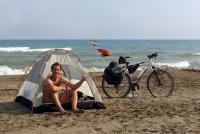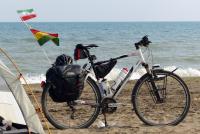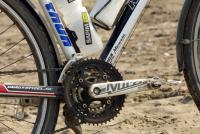Bike review at halfway

Mister havarjuu thenksfaajn... this the English knowledge of the average Persian. I asked the same question from my Kenzel bike the other day, and luckily it responded in similar fashion. It has been 38 days since the launch and I was sitting in the saddle for 32 days; 3220km on asphalt, gravel, in hot sand on the shore, in mud, in pouring rain, in around zero degrees cold till 50 degree hot heatstroke, through broken glass till bushes full of thorns. It had its share of everything, and it had to carry me and at least additional 30kg of equipment.
I will tell you honestly; at the beginning of the expedition I was sceptic about some of the components. My doubt was even deepened by the fact that some manufacturers entrusted me with entirely new products, hoping that it will work well in a long lasing field test. I still have the half of the distance before me, so I knock-on-wood that all I describe bellow will stay the same way, and that I won’t have to spend more time with repairs.
The soul of the bike is its frame, which in this case it the newest aluminium trekking frame from Kenzel company. The geometry of the frame is very well designed. Even after a whole day long trek I don’t feel either my back, or neck, or wrist hurting. The long head tube makes the ride comfortable and due to the higher seat position they see me well also in the city traffic and I am also able to see above the cars. The shape of the tubes give the frame stability, it is not even bending when standing on the pedals. Drilling trough the head tube was an excellent idea, as of it I am able to fix the front wheels position by a pin during parking. With this the additional load from the bags will not pull on the front wheel and also the load on the kickstand is better.

The suspension fork is a different story. On the “offroad” track on the roads of Moldova, Ukraine and Georgia the suspension lost its sensitivity. Currently it is not doing what I should, to eliminate the bumps of the road. Now it is just one addition death weight on the bike. But luckily the roads in Iran are superb, so I don’t feel the missing suspension.
One additional important part of the bike is the wheels. I am extremely pleased with my wheels. It is almost unbelievable what they did get me though. The Schwalbe Mondial tires show no sign of wear. I haven’t had a puncture. The pressure was checked after 2700km, and even after that distance the pressure just dropped from maximum to minimal allowed. It was back on max in a minute. The Sapim spokes in the Remerx rims are even tenser then at the start. The lacing work is the testament of István’s craftsmanship from the Piko bicycle shop.
The brakes from Miranda had also proven their worth. This is confirmed by the fact that I already had to change one set of pads and the second is just getting ready to be changed. The mountains of Georgia and Armenia were steep and the roads pretty bed; often I was only able to descend by constant breaking. But luckily they always worked when I needed them, so I am satisfied with them as well.

The propulsion is the system, which, if it would break down, would prove difficult to repair in the near East. Luckily it is working well. The bottom brackets from Thun have seen a lot of rain and dust, but it is keeping up the good work, it is rolling just as smoothly as at the launch. The crank set from Miranda lost nothing from its stiffness. According the chain measuring tool the KMC chain is just about ready to be changed, although it just is getting used to the Shimano SLX components. The propulsion is now working most smoothly.
The component I was mostly sceptic about was the pedal without a shaft, the Tioga MT Zero. Its shape is thin and it looks fragile. The pedal was predicted a short life by many. Luckily it runs as perfect as on launch. Of course it happened that trying getting away from a horde of dogs I did not noticed a larger rock on the road, and hit it with the pedal. The bike was thrown off balance a bit by the hit, but you can see no sign of impact on the pedal.
The Accentia Fortis saddle was an excellent choice for the long ride; also the Herrmans grips just slightly show marks of wear. The integrated grip is quite super; while standing on the pedals, I create larger force by pulling the bike to myself.
The next thing, which I was sceptic about, was the M-Wave waterproof bags. After using them for more than a month all my doubt is gone. The back bags can hold an immense amount of stuff. I used to place around 10kg of weight into each of them. They are easily and quickly fastened and proven that they are waterproof multiple times already.
The rear carrier was already a used part, as I used it on my previous expedition bike as well with more than 15 thousand kilometres on it. Maybe that’s why after 2700km it gave in on the load and one of the legs broke. But I did not find this an issue, as a good rear carrier for an expedition is good not because it cannot break; it is good because it is made from steel. And steel can be repaired almost on every corner. This is what happened to me as well. Just after half an hour after, disassembly and assembly included, it broke it was repaired already.
The fixation of the RPZ mudguards is perfect. They don’t rattle, don’t clink. The rear mudguard could have been made a bit longer and then it would prevent dirt and water to get on the bags and the rear light. But as it is not longer, water gets directly into the circuit of the rear light, which than gets crazy. It either turns itself on or just simply cannot be turned off.
Well, these are my experiences with the bike so far. I am planning to share my experiences with you also after the expedition and I hope I will be able to present you with similarly good reviews that time as well..
